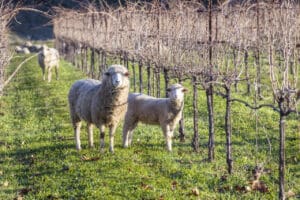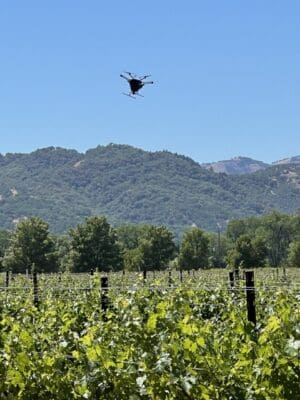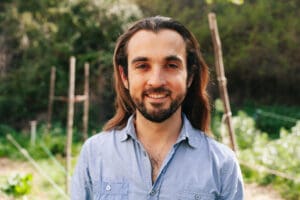Bonterra Organic Estates’ Joseph Brinkley talks about his move away
from the day-to-day vineyard operations to focus on the development of
regenerative organic agriculture at a larger scale.
By Thomas Grandperrin
Farmers are known for their tireless dedication to the daily demands of farming, leaving little time to advocate for their rights and drive industry-wide change. Although the topic of regenerative agriculture has gained significant traction with a growing number of advocates, effecting change in long-standing practices and scaling its adoption necessitates a systemic approach led by farmers and other industry stakeholders.
Fortunately, there are growers and companies that not only prioritize internal practice transformation but also actively promote change on a broader scale. To gain insights into the macro-level actions driving regenerative agriculture, I had the opportunity to speak with Joseph Brinkley, an experienced viticulturist who is now advocating for regenerative agriculture at both farm and policy levels.

Brinkley currently serves as the director of regenerative farming at Bonterra Organic Estates (formerly known as Fetzer Vineyards) in Mendocino County, Calif. Joining the company in 2013 as the director of viticulture, he spearheaded the drive to obtain regenerative organic certification, drawing upon Bonterra’s four decades of organic farming expertise, which had already implemented techniques such as cover cropping and animal grazing.
Once in his current role, Brinkley moved away from the day-to-day vineyard operations to focus on the development of regenerative organic agriculture at a larger scale.
Promoting legislation
Throughout our conversation, we explored the pivotal role of legislation in fostering regenerative organic agriculture, Bonterra Organic Estates’ efforts to raise awareness among growers and consumers, and the various tools available to address pest challenges faced by regenerative organic growers.
“As the current Farm Bill is set to expire at the end of September 2023, climate-smart agriculture advocates are engaging in discussions and sharing with congressional representatives their priorities for the next five years of legislation,” he says. “Some companies have joined forces under the umbrella of nonprofit organizations such as the Ceres Climate Smart Agriculture and Healthy Soil Working Group. Among the five priorities defined by Ceres for the 2023 Farm Bill, the team at Bonterra is lending its expertise to specific areas.”
![Joseph Brinkley in front of Capitol Hill, Washington DC, May 2023 [Credit: Bonterra Organic Estates]](https://wineindustryadvisor.com/wp-content/uploads/2023/06/Joseph-Brinkley-on-Capitol-Hill_May-2023-300x274.jpg)
Brinkley then highlighted some of the priority areas that need to be addressed to create long-term change. “One piece we’ve been advocating for in the Farm Bill aims to encourage additional research. If we can obtain more funding for research on organic and regenerative farming, we can alleviate the burden on growers and share it with universities and research institutions to help find necessary solutions.”
On behalf of Bonterra, Brinkley is also advocating for increased funding for technical assistance. This would provide farmers with support, knowledge and funds for transitioning to organic. He explains that raising awareness about proven and cost-effective alternatives to conventional farming practices is still highly necessary. “Technical advisors’ support to the growers in their community relies on their knowledge base. But there are still a lot of places in the United States — and in the world — where technical advisors are not yet well-versed in organic or regenerative organic practices.”
The team at Bonterra believes reforming crop insurance should be another priority, due to the increasing frequency of extreme weather events (including droughts and floods) caused by climate change that impact farmers. It argues that farmers who adopt practices to improve soil health and sequester carbon need to be incentivized and provided with a safety net, especially since regenerative practices have proven to make farms more resilient to extreme events, both in perennial and annual crops.
To drive change, Brinkley says consumers can have a significant impact through their purchasing decisions. “When you buy something, you’re essentially voting for that product to continue.”
However, he acknowledges, not everyone has the option to purchase organic or regenerative products due to economic constraints, limited availability or a lack of knowledge about the food production system. Thus, he argues, policy changes are important to support organic agriculture not only performed by large corporate companies but also by smaller and independent farmers.
For example, he believes that, to assist customers in navigating through an overwhelming amount of information, which can sometimes be misleading, we should “increase consumer awareness. One way to achieve this is by implementing robust certifications, which can help address the issue of greenwashing.”
Educate producers
In addition to promoting regenerative agriculture to state and federal policymakers, Brinkley and his team at Bonterra Organic Estates are also doing their part to educate producers and customers. Their initial tangible action is to collaborate with growers to assist them in obtaining the organic certification which will let them supply grapes for the Bonterra brand.
“We bring them additional technical support, showing how we farm organically on our estate vineyards, the issues that we’ve faced and the things that have worked for us,” he says. “We really encourage knowledge sharing both ways.”
![Regenerative Organic workshop organized at Bonterra’s McNab Ranch in April 2023 [Credit: Bonterra Organic Estates]](https://wineindustryadvisor.com/wp-content/uploads/2023/06/Field-Day-Bonterra-300x226.jpg)
Bonterra Organic Estates organizes field days for its growers and anyone interested in regenerative agriculture. These events showcase presentations from other viticulturists and regenerative organic stakeholders who work with different types of crops. The objective is to unite the community of growers, promote experience sharing, discuss new equipment and products, and, ultimately, enhance the knowledge base required to enter into an organic or regenerative farming program.
“Having more of that community dialogue and outreach is really helpful, too. We learn a lot from each other,” Brinkley comments.
To contribute to customer education, a few years back the Bonterra brand launched an ad campaign called “Experience the Taste of Saving the Planet.” More recently, it launched a new marketing campaign, “Cultivate the Future,” which focuses on bettering the future of our planet through regenerative organic practices. While these campaigns promote the Bonterra brand, they also seek to raise awareness among consumers about regenerative farming, which benefits the industry as a whole.
Ecological benefits
The ecological benefits of regenerative organic agriculture are now widely discussed and increasingly known within the agricultural community. However, as growers face consistently rising input costs and occasional lower market prices for their harvest, it’s the expected economic advantages of this farming approach that can encourage them to start the transition to regenerative practices.
“The cost of inputs used in the vineyards, such as fertilizers, pesticides, herbicides and petrol, are continuing to go up much more rapidly than the price of the produce,” Brinkley explains. “I think it’s becoming more and more clear that we cannot just look at yield by itself, but what it costs to get the yield. And we don’t even talk about true cost accounting that would take into account the negative externalities of conventional farming on the environmental and social level, which is an entirely other topic.”
He opines that if, through the adoption of regenerative practices, growers can reduce input costs without compromising yield or quality, it can represent a significant commercial advantage for them. To illustrate this point, he explains that, “as you start to see the soil health improve, pest pressure will decrease, reducing the cost of the material required to manage that problem. Soil health also brings longer-term gain, which would then relate to productivity and quality of the crop you’re growing.”
In grape farming, similar to many other crops, hand labor is typically the primary cost factor, followed by input costs and farm asset depreciation. As a grower, assisting the field crew in making efficient use of their time and reducing input costs is crucial, according to Brinkley.
However, when discussing the cost of regenerative organic versus conventional farming, he emphasizes the importance of looking beyond the year-to-year farming costs, particularly in perennial crops such as vineyards. “We need to spread the cost over the entire life of a vineyard,” he insists.
Regarding asset depreciation, Brinkley comments on the economic benefit of improved soil health resulting from regenerative practices that is often overlooked when comparing costs with conventional farming. “Replanting a vineyard is not cheap. If regenerative farming practices can extend the lifespan of a vineyard to 40 or 50 years — or longer — instead of the typical 20 to 30 years, the cost savings are considerable,” he says. “Considering that it costs around $30,000 per acre to replant, spreading that investment over a few more years or decades can make a significant difference in your profit margin.”
There are many arguments supporting the idea that implementing regenerative practices is a good strategy to ensure a farm’s long-term resiliency and economic sustainability. As Brinkley reminds us, these practices are in addition to the incentives coming from the current market demand. “We’re seeing a growing appetite in the marketplace for products that carry an organic or regenerative seal,” he says. “Organic is growing rapidly.”
The latest numbers from the Organic Trade Association’s (OTA) 2023 organic industry survey show promising trends. Overall sales of organic products increased 4% in 2022, almost double the overall growth of 2.3% in 2021. In 2022, incremental sales of organic products increased $2.6 billion, year-over-year, to reach $67.6 billion.
A holistic approach
When transitioning away from conventional farming practices, pest and disease management requires a different, more holistic approach. For growers starting new projects, it can begin with selecting the right site for a specific crop. Brinkley comments that, “At Bonterra’s estate vineyards, we are growing on the north coast of California, which is certainly one of the best climates to grow vinifera. I’ve grown vinifera on the East Coast of the United States, and we were constantly faced with diseases that nobody’s ever heard of on the West Coast.”

However, even with the best effort made at the planning stage, powdery mildew and trunk diseases can still be an issue in this part of California. On the pest side, spider mites are a common concern. Brinkley has always been a fan of finding natural cycles and creating a balance on the farm. “We just try to think of ways to mitigate either the attraction or the impact of the pest,” he says.
He describes how Bonterra applies this approach in its own vineyards. “To mitigate factors that favor the development of spider mites, we focus on ensuring the vines are healthy and reducing dust load. We don’t aim to eradicate every mite, but rather to find a balance in the farm ecosystem. To complete these cultural practices, organic growers can use beneficial predatory mites to eat the pest mites. Drones can even be used to release them, covering large areas in a well-timed and efficient manner,” he says.
Similarly, when it comes to mildew, he explains, “If you ensure sufficient air and light flow, manage your water and nitrogen levels, mildew becomes less of a concern.”
These practices are relevant not just for regenerative organic farms: “Even in the conventional vineyards I’ve worked in the past, if we weren’t on top of it, mildew would get out of hand. And that’s with systemic, conventional chemistry. So much of it is the cultural management of the crop after you pick the right place for it to be.”
For pests, diseases, and weeds, Brinkley says, “Timing is critical. Especially on the regenerative organic side, we’re essentially looking at prevention. Prevention is our main management tool against pests and diseases. If we get the timing right, the entire growing season goes much better than if we’re even a week or two weeks late on any of those pieces.”
Brinkley views pests and diseases as indicators expressing the current state of the vineyard’s health and how well it’s managed at a specific point in time. “It’s almost like we’re in conversation with our vineyards,” he says. “Like if those pests and diseases were telling us farm managers, ‘Hey, you missed something. You did this wrong. You did too much of this or not enough of this, or too late.’ And sometimes, the way they speak to us is with an outbreak.”
However, he acknowledges the complexity of pest management and how it varies depending on location, farming approach and experience, and even the actions of neighboring farms. He remembers that, “When I was farming in Napa, we were kind of wall-to-wall. So even if you are on track with your mildew management program, if your neighbor isn’t, those spores are happy to get blown into your vineyard and create an issue. There’s a lot of dynamics at play in farming.”
Cost control
Brinkley addresses the challenge of rising costs both from the perspective of conventional and organic growers and suggests that it is helpful to question the necessity of performing some tasks that have been previously considered compulsory.
He uses leafing as an example, stating that “For a long time, most winegrape growers would pull leaves from the morning side, regardless of the variety, season or circumstances, and they would always leave the leaves on the afternoon side for protection. This certainly holds true for varieties such as Chardonnay and Sauvignon Blanc, which have a higher incidence of mildew and other fungal diseases. However, for some reds, such as Cabernet, leafing can be completely eliminated depending on the vineyard, the size of the leaves and the vineyard’s history.”
Like other forward-thinking growers, Brinkley recommends combining tasks whenever possible. “Depending on how your tractors are set up, attach two implements, such as a front under-vine machine with a rear-pulled mower, or vice versa, and that way save a pass — sometimes you can even forgo a pass.”
As a farm manager, he says, it’s necessary to take a step back from time to time. “If hand labor is really the main driver of vineyard costs, is there a way to optimize or skip a pass without having a detrimental effect on the quality or quantity of grapes?”
Brinkley recommends every grower test their own beliefs. “It is helpful to get out and see some neighbors or even some folks that are not in your geographical community. See other people and share ideas. Farmers are always innovating because it’s basically the nature of survival for farmers. If you’re not innovating, you’re not going to stick around long.”
In conclusion, Brinkley says, “When looking out into the world, there may be plenty to be pessimistic about, but there is also much to be hopeful for. The regenerative agriculture movement is continuing to grow, gaining momentum and traction. At Bonterra Organic Estates, we have been working to approach this in several ways. We need to work at every level: consumer level, business level, policy level and educational level. I don’t think it’s just one thing. I believe it’s a combination of efforts that will move us forward.”
Editor’s Note: If you’re interested in learning more about regenerative farming and agricultural mitigations against climate change, check out Growing Forward, an online conference series focused on educating and supporting grapegrowers throughout the vineyard growing cycle. The series features academics, agricultural experts and notable industry professionals addressing current challenges and issues impacting the grower community. Growing Forward will take place July 19, 2023. More information, including panel sessions and registration, will be coming soon. wineindustryadvisor.com/growingforwardvineyardconference
______________________________________________________________________

Thomas Grandperrin
Thomas Grandperrin is the biocontrol evangelist at UAV-IQ Precision Agriculture, which is helping organic and conventional growers implement biocontrol in an efficient and cost-effective manner by using drones to release beneficial insects exactly when and where they’re needed to suppress pests. This article is part of a series on biological control and sustainable farming written by UAV-IQ.


















